Mid-Suffolk Light Railway
| Mid-Suffolk Light Railway | |
|
Suffolk | |
|---|---|
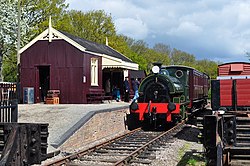 Falmouth Docks in full steam. | |
| Location: | 52°15’1"N, 1°7’4"E |
| No. of stations: | 1 |
| Track: | ½ mile |
| Information | |
| Operated by: | Mid-Suffolk Light Railway |
The Mid-Suffolk Light Railway (know to its friends and supporters as The Middy) is a half-mile heritage railway in Suffolk. In its commercial heyday this was a branch line which ran for 19 miles from Haughley to Laxfield, Suffolk. The line became part of the London and North Eastern Railway in 1924 and the last trains ran on 26 July 1952.
The preserved railway is now both a heritage railway and preservation museum run by a small but dedicated band of volunteers. The Mid-Suffolk Light Railway is currently the only steam preservation railway in Suffolk, and there are plans to extend the line.
History
Construction
The original Mid-Suffolk Light Railway was intended to run from Haughley to Halesworth, with a second branch running from Kenton station to Westerfield near Ipswich. The Mid-Suffolk Light Railway, or Middy as it became affectionately known, was built to provide transport to the rural Suffolk communities who had no reliable transport links. It was built in accordance with the 1896 Light Railways Act, which allowed for cheaper construction methods in return for a speed restriction of 25 mph. The railway was built as cheaply as possible: the buildings were constructed using corrugated iron, and the route followed the natural contours of the land to minimise the need for embankments and bridges. The section from Haughley to Laxfield was completed and open for passenger traffic. Beyond Laxfield the line was built for approx mile to Cratfield over which an occasional freight train was run but the section fell into disuse. Some earthworks were begun between Cratfield and Halesworth but these were soon abandoned with now no evidence remaining. The section of about two miles of the branch from Kenton to Westerfield was completed as far as Debenham and a few goods trains were run but this also was soon abandoned. Some sections of trackbed and embankments still survive.
Opening
The railway was built too late, long after the great Victorian railway boom, and soon came into financial difficulties. The planned railway had troubles from the very beginning, having disputes with the neighbouring Great Eastern Railway and local landowners. The railway was bankrupt before it opened and it was pure determination that kept the Middy running.
On 23 September 1902, Lord Kitchener visited the still incomplete railway after spending the night at Aspall. He travelled over the railway from Brockford to Haughley, where he continued his journey to Stowmarket by road.[1]
The railway opened to freight traffic in 1904 with the hope that this would bring in enough income to complete the line, but by 1908, although the line was making an income, it still was not enough to cover its original debts and for work to continue. Finally on Tuesday 29 September 1908 the line was opened to passengers with two trains in either direction on weekdays, but this failed to bring great trade as many of the stations were sited miles from the communities they were meant to serve.
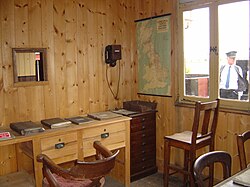
In 1924 the Middy lost its independence and was grouped together with the London and North Eastern Railway, but apart from the replacement of second-hand rolling stock, the railway continued as it always had done.
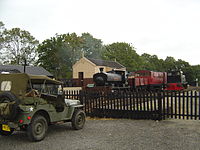
Passenger traffic declined over the next couple of decades in the coming age of the motorcar and road freight. However, with the Second World War and petrol rationing, the Middy became an important transport link. The American airbases built near the Mendlesham and Horham stations, the line was relied upon for transporting military equipment and regularly used by American serviceman. The war brought more traffic to the line – both goods and passengers – as the railway became important in helping the war effort.
After the war the Middy was absorbed into British Railways in 1948, but a poor line it was, neglected, decayed and exhausted by usage during the War. However the line became an attraction for enthusiasts and railway management due to the picturesque landscape through which the railway ran; and its informal atmosphere. The end of the war meant a surplus of ex-army lorries which took away the agricultural business, the main source of income for the line. The Middy eventually closed in 1952, 44 years after it had opened for passenger traffic.
Renaissance
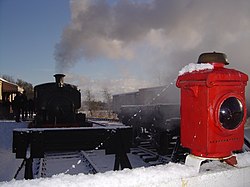
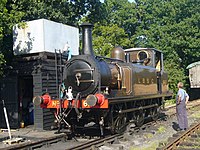
Nearly 40 years after it closed, a group of enthusiasts formed a Company to recreate the Middy on the site of the Brockford and Wetheringsett railway station, now the corner of a large field.
The Mid-Suffolk Light Railway Society had an ambitious task ahead of them due to the temporary nature of the original line. As far as is known, no coaches or locomotives of the Middy are still in existence and the corrugated iron buildings were either left to rust or sold to become farm sheds. However, the Company has been recreating typical scenes from the Middy's past by using restored coaches and wagons that would have run on its bigger neighbour, the Great Eastern Railway, and its successor, the London & North Eastern Railway. The Society has been able to collect a number of Great Eastern coaches, two are now in working order, with many more under restoration. The museum has also been able to collect the remaining station buildings from former Middy railway stations.
Non-railway material
The one aim of the society which makes it stand out from any other railway museum is that they are not just interested in getting a locomotive and coaches and taking passengers up and down the line. Goods wagons, road going railway delivery vehicles and line side material are given just as much care and attention as the main attractions.
Another aim of the society is to bring together an archive of photos and original artefacts from the working life of the Mid-Suffolk Light Railway. Many of these are on display at the museum.
Operation
The museum operates from April to the end of September on Sundays and Bank Holidays, with Santa specials in December. Many of the Open Days have a Special Event to accompany the running of the steam locomotive.
A full list of the events and activities can be found on the Mid-Suffolk Right Railway web site.
Locomotives
- LNER Class J64 (the reclassification of the original 3 MSLR engines)
- LNER Class J65
- LNER Class J15
Current
The museum currently has five locomotives on site, "1604" which is under restoration, and a Ruston diesel named "Alston". The museum also uses privately owned locomotives for the steam events:
- Cockerill 0-4-0VBWT Works number 2525 – operational, privately owned
- Bagnall 0-4-0ST Works number 2565 – operational, privately owned
- Hudswell Clarke 0-6-0ST "Wissington" – operational on loan from the North Norfolk Railway
- Hudswell Clarke 0-6-0ST Works number 1604 – under restoration
- Ruston 0-4-0DM diesel-mechanical "Alston" – operational (used mostly for shunting)
Previous
- LNER Class J15 0-6-0 BR No. 65462 Built in 1912.
- LB&SCR A1 class 0-6-0T 'Martello' No.662 Built in 1875.
- Andrew Barclay 0-4-0ST 'Little Barford' Built in 1939.
- Hawthorn Leslie 0-4-0ST "Falmouth Docks and Engineering Co. Loco No. 3"
Rolling stock
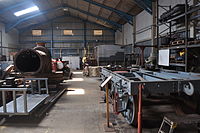
- GER 180 Horse box built 1869. Restored and in service.[2]
- GER 278 Four-wheel Third built 1876, under restoration
- GER 13 Four-wheel Brake Third (body only) built 1875, Body on chassis ex LNER 'Queen Mary' type brakevan. Operational from 2003.
- GER 1266 Third (body only now on ex-tube wagon uderframe) built 1891, Operational from 2009
- GER 287 Third (body only) built 1876, under long term restoration
- GER 140 First (body only) built 1863. under restoration
- GER 424 Third, later Second (body only) built 1892, under restoration
There are also several wagons and freight Items that are under restoration and operational.
Some signs of the original rolling stock is visible in the countryside surrounding the railway. One example is a carriage used on a farm outside Mendlesham (52°14’56"N, 1°3’37"E).
On film and in books
The Middy was short-listed as the location for the 1952 Ealing Studios film The Titfield Thunderbolt, but the Camerton and Limpley Stoke line south of Bath was used instead.
The Railway was used as inspiration for the John Hadfield novel, Love on a Branch Line. The book was first published in 1959 and was turned into a television series of the same name in 1994.
Outside links
| ("Wikimedia Commons" has material about Mid-Suffolk Light Railway) |
- The Mid-Suffolk Light Railway Society – official website
- The London & North Eastern Railway (LNER) Encyclopedia
- The Great Eastern Railway Society
- Aspall and Thorndon station (MSLR line) on navigable 1946 O. S. map.
- The Vintage carriage trust website
References
- ↑ Comfort 1997, p. 17.
- ↑ "Restored railway horsebox ready for passengers". BBC News Online. http://www.bbc.co.uk/news/uk-england-suffolk-27585570. Retrieved 31 May 2014.
- Comfort, N. A. (1986) [1964]. The Mid-Suffolk Light Railway (2nd ed.). The Oakwood Press. ISBN 0-85361-338-9.
- Comfort, Nicholas (1997) [1964]. The Mid-Suffolk Light Railway. Locomotion Papers (3rd ed.). Headington: Oakwood Press. LP22. ISBN 0-85361-509-8.
- Paye, P. (1986). The Mid-Suffolk Light Railway. Wild Swan Publications. ISBN 1-874103-81-X.
